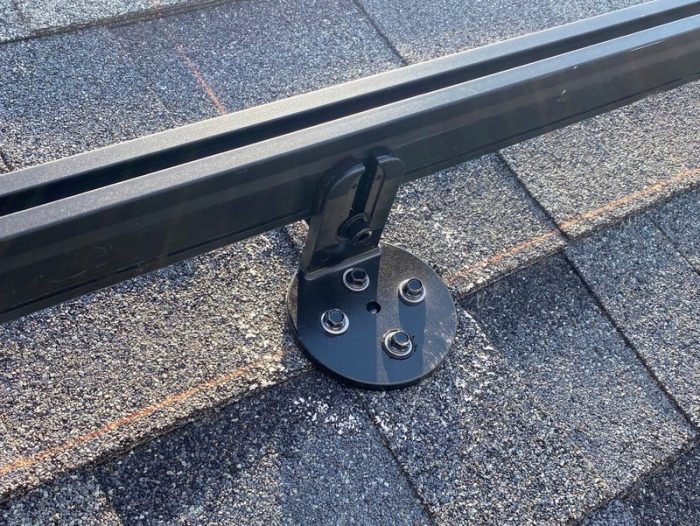Why deck attachments are trending in residential rooftop solar mounting

The most common method for installing solar roof attachments onto residential pitched roofs is to secure an L-foot with flashing to the roof by installing a lag screw into a roof rafter. Rafters are structurally sound, after all, and mounting to them means fewer mounts, which can mean fewer holes and less work.
But, locating those rafters isn’t easy, and neither is hitting them dead square, especially with a lag bolt. Rafter attaching can mean just as many extra holes that then need repaired. The number one solar PV system rooftop leak is from pilot holes not being properly flashed or caulked.
Deck (sheathing) attachment means more overall penetrations, but it can be a more leak-proof approach in total. Also, more attachments doesn’t necessarily mean more time.
“Deck mounting is an evolutionary step in residential roof top solar installation,” says Roland Jasmin with SunModo. “Solar installers find that deck mounts are faster to install because they don’t have to locate the roof rafter. With a deck mount roof attachment system, the roof attachments are simply laid out and installed on the roof without the worry of locating the rafter, splitting rafter or missing the rafter altogether.”
Two disadvantages to deck mount roof attachments, according to Jasmin: 1) They are not approved for use in all regions of the country (so you will want to check with your AHJ before installing a deck mount system on the roof), and 2) deck attachments are not as strong as rafter attachments (thus, why you need more of them)
Putting decking to the test
In this episode of The Pitch, Michael Dunlap with Roof Tech, notes: “Structurally speaking, the point load is the issue when it comes to down pressure on a rafter vs. down pressure on decking. If you choose to do decking, you will be possibly be using more attachments to compensate for the point pressure, but that really only comes into play for snow load areas. They will have much smaller spans per attachment, but you can go up to 8 feet spans in Southern Texas where it’s all about uplift. The uplift in sheathing vs. rafter is pretty comparable.”
Roof Tech, which has been manufacturing deck attachments for 27 years in Japan, is finding even better ways to get the most out of building materials.
“Testing decking attachments is not the same as testing rafter attachments,” Dunlap says. “There are more variables for how sheathing is placed on a roof, and we also attach per size of sheathing. So, now we have more testing methods to better duplicate real life scenarios. Before, we had smaller sections of real life scenarios and were a lot more conservative in our ratings than what they can handle. With more lifelike tests, we can learn more about moving that line.”
As installers get more comfortable with deck attachments, Dunlap says this could drive more interest in rail-less attachments: “One of the advantages of using a decking attachment for rail-less is you’re not confined to the rafter layout of the project. But on top of that, you have about a 43 percent reduction in point loading because you’re spreading out those point loads over multiple connections on the rail-less system versus single connections on the rafters maximally spaced.”
Options abound
Most manufacturers, as you’ll see in our 2021 Rooftop Mounting Buyer’s Guide, seem to be offering both options now, some doing both from a single product SKU.
SunModo’s NanoMount can attach to rafters or straight to deck without the need to lift shingles to install traditional large metal flashings. It forms a watertight seal by compressing its integrated sealing gasket tightly against the asphalt roof shingle and is installed by using four self-drilling wood screws and sealing washers. Similarly, SunModo’s TopTile Mount can mount directly into roof decking above roof tiles.
QuickBOLT’s Deck Mount has Silicon embedded into it and is secured to the roof with Stainless Steel Screws assembled with Umbrella Washers. The L-Foot is built into the mount and comes with all hardware needed.
Ecofasten’s ECO-65 is a direct-to-deck attachment specifically for use on low-slope roofs constructed of rolled asphalt or membrane (TPO, EPDM, PVC). The mount itself features two studs for attachment, which allows the use of larger compression brackets when needed.
Roof Tech’s MINI II (rail) and its RT-APEX (rail-less) can both go to rafter and/or deck. The RT-APEX is a self-flashing mount made of proprietary butyl rubber (AlphaSeal) and has a service temperature between -40 F to 250 F, which surpasses common sealants used for roofing. Because RT Apex is fastened with 5mm stainless wood screws, it is not necessary to drill pilot holes and pre caulking.





Comments are closed here.